一般现在时情态动词句型转换
- 格式:doc
- 大小:19.00 KB
- 文档页数:2
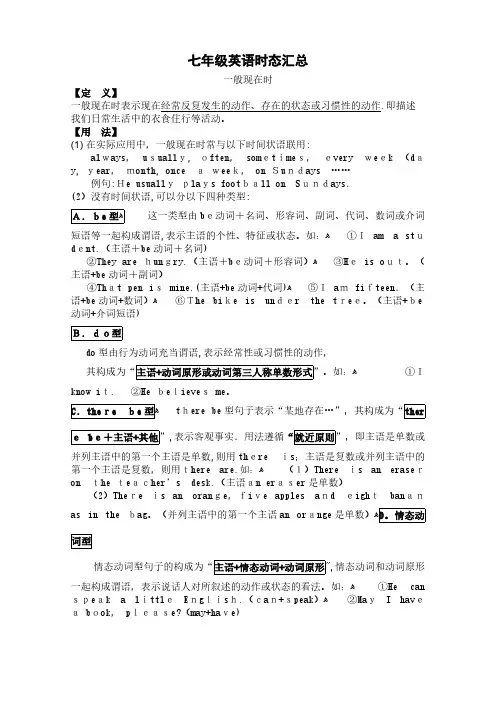
七年级英语时态汇总一般现在时【定 义】一般现在时表示现在经常反复发生的动作、存在的状态或习惯性的动作.即描述我们日常生活中的衣食住行等活动。
【用 法】(1)在实际应用中,一般现在时常与以下时间状语联用:always,usually, often,sometimes,every week (day, year,month, once aweek, on Sundays ……例句:He usuallyplays football on Sundays.(2)没有时间状语,可以分以下四种类型:A.be型ﻫ这一类型由be动词+名词、形容词、副词、代词、数词或介词短语等一起构成谓语,表示主语的个性、特征或状态。
如:ﻫ①Iam a student.(主语+be动词+名词)②They are hungry.(主语+be动词+形容词)ﻫ③He is out。
(主语+be动词+副词)④That pen is mine.(主语+be动词+代词)ﻫ⑤I am fifteen.(主语+be动词+数词)ﻫ⑥The bike is under the tree。
(主语+be动词+介词短语)B.do型do型由行为动词充当谓语,表示经常性或习惯性的动作,其构成为“主语+动词原形或动词第三人称单数形式”。
如:ﻫ ①I know it. ②He believes me。
C.there be型ﻫthere be型句子表示“某地存在…”,其构成为“ther ebe+主语+其他”,表示客观事实.用法遵循“就近原则”,即主语是单数或并列主语中的第一个主语是单数,则用there is;主语是复数或并列主语中的第一个主语是复数,则用there are.如:ﻫ (1)There is an eraseron the teacher’s desk.(主语an eraser是单数)(2)There is an orange,five apples and eight bananas in the bag。
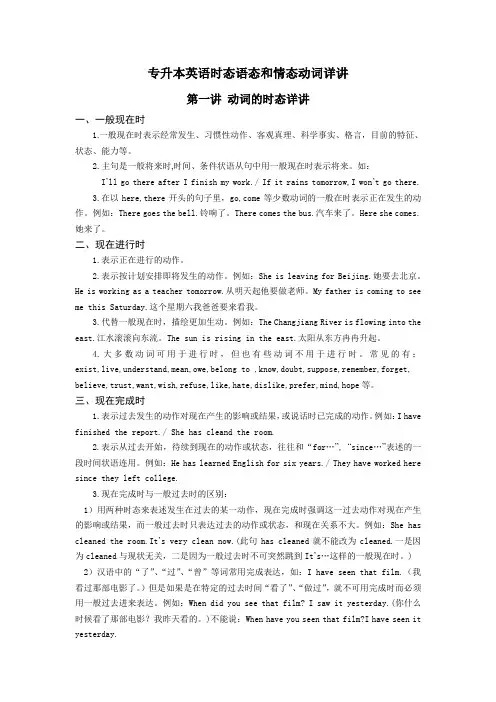
专升本英语时态语态和情态动词详讲第一讲动词的时态详讲一、一般现在时1.一般现在时表示经常发生、习惯性动作、客观真理、科学事实、格言,目前的特征、状态、能力等。
2.主句是一般将来时,时间、条件状语从句中用一般现在时表示将来。
如:I’ll go there after I finish my work./ If it rains tomorrow,I won’t go there.3.在以here,there开头的句子里,go,come等少数动词的一般在时表示正在发生的动作。
例如:There goes the bell.铃响了。
There comes the bus.汽车来了。
Here she comes.她来了。
二、现在进行时1.表示正在进行的动作。
2.表示按计划安排即将发生的动作。
例如:She is leaving for Beijing.她要去北京。
He is working as a teacher tomorrow.从明天起他要做老师。
My father is coming to see me this Saturday.这个星期六我爸爸要来看我。
3.代替一般现在时,描绘更加生动。
例如:The Changjiang River is flowing into the east.江水滚滚向东流。
The sun is rising in the east.太阳从东方冉冉升起。
4.大多数动词可用于进行时,但也有些动词不用于进行时。
常见的有:exist,live,understand,mean,owe,belong to ,know,doubt,suppose,remember,forget, believe,trust,want,wish,refuse,like,hate,dislike,prefer,mind,hope等。
三、现在完成时1.表示过去发生的动作对现在产生的影响或结果,或说话时已完成的动作。
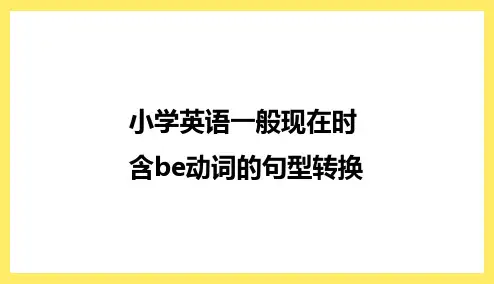

英语语法一般现在时,结构、用法全打尽!(附习题)一般现在时(The Simple Present Tense)是我们英语学习中接触到的第一个时态,也是初一英语最重要的语法内容之一。
和老师全方位学习一下吧!一. 一般现在时有三种形式1. 谓语是be(am/is/are)的一般现在时。
①肯定形式:主语+be+表语(形容词、名词充当表语)。
I am hungry.You are beautiful.He is a doctor.②否定形式:主语+be+not+表语(形容词、名词充当表语)。
I am not hungry.You aren't beautiful.He isn't a doctor.③一般疑问句形式:Be+主语+表语(形容词、名词充当表语)?肯定回答:Yes,主语+be. 否定回答:No, 主语+ be+not.—Are you hungry?—Yes,I am./No,I'm not.—Is he a doctor?—Yes, he is./No, he isn,t.④特殊疑问句形式:特殊疑问词+Be开头的一般疑问句?—What is he?—He is a doctor.注意:be要随着主语变。
2. 谓语动词是实义动词(及物动词或不及物动词)的一般现在时。
①肯定形式:“主语+及物动词+宾语”或“主语+不及物动词”。
She has a little brother.她有一个弟弟。
The sun rises in the east.太阳从东方升起。
②否定形式:“主语+don't/doesn't+及物动词+宾语”或“主语+don't/doesn't+不及物动词”。
She doesn't have a little brother.她没有弟弟。
I don't eat every morning.我每天早晨都不吃饭。
③一般疑问句形式:“Do/Does+主语+及物动词原形+宾语”或“Do/Does+主语+不及物动词原形”。
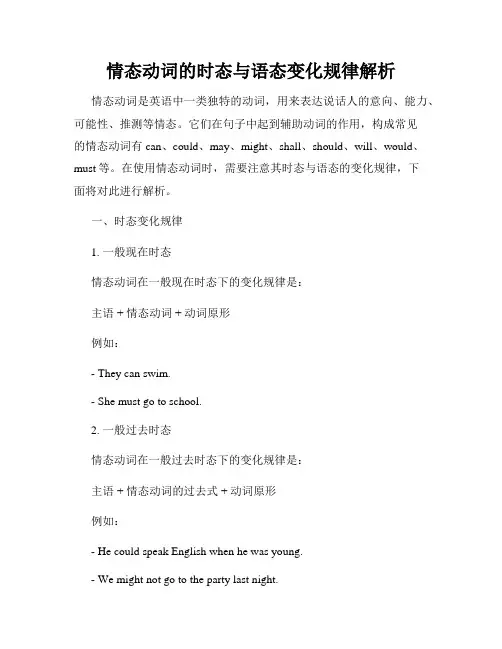
情态动词的时态与语态变化规律解析情态动词是英语中一类独特的动词,用来表达说话人的意向、能力、可能性、推测等情态。
它们在句子中起到辅助动词的作用,构成常见的情态动词有can、could、may、might、shall、should、will、would、must等。
在使用情态动词时,需要注意其时态与语态的变化规律,下面将对此进行解析。
一、时态变化规律1. 一般现在时态情态动词在一般现在时态下的变化规律是:主语 + 情态动词 + 动词原形例如:- They can swim.- She must go to school.2. 一般过去时态情态动词在一般过去时态下的变化规律是:主语 + 情态动词的过去式 + 动词原形例如:- He could speak English when he was young.- We might not go to the party last night.3. 一般将来时态情态动词在一般将来时态下的变化规律是:主语 + 情态动词 + 动词原形例如:- We will visit our grandparents tomorrow.- They may come to the party next week.4. 现在进行时态情态动词在现在进行时态下的变化规律是:主语 + be动词 + 情态动词的现在分词 + 其他动词例如:- She is canning the fruits.- They are maying to the beach.5. 过去进行时态情态动词在过去进行时态下的变化规律是:主语 + be动词的过去式 + 情态动词的现在分词 + 其他动词例如:- He was canning the fruits.- They were maying to the beach.二、语态变化规律1. 情态动词的主动语态情态动词的主动语态表示说话人的意愿、能力、可能性等,其变化规律与时态一致,即:主语 + 情态动词 + 动词原形例如:- He can swim.- They must finish the project.2. 情态动词的被动语态情态动词的被动语态表示说话人对某种行为的推测或可能性,其变化规律如下:主语 + 情态动词 + be动词的过去分词 + 其他动词例如:- The book can be read by everyone.- The food must be eaten before it spoils.综上所述,情态动词在使用时需要根据不同的时态与语态进行变化。
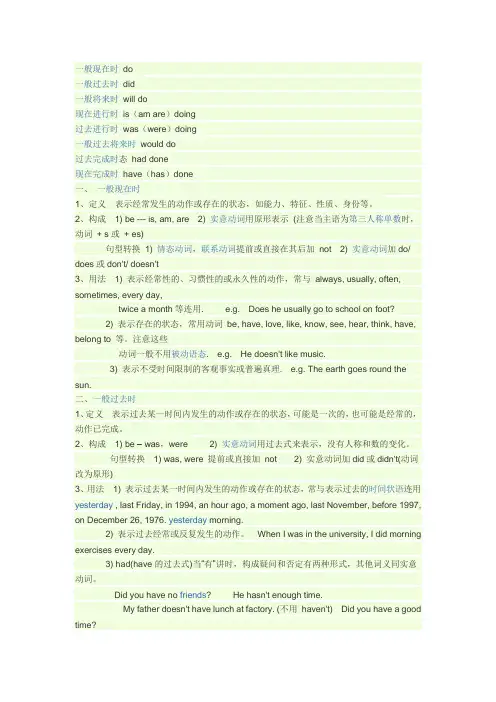
一般过去时did一般将来时will do现在进行时is(am are)doing过去进行时was(were)doing一般过去将来时would do过去完成时态had done现在完成时have(has)done一、一般现在时1、定义表示经常发生的动作或存在的状态,如能力、特征、性质、身份等。
2、构成1) be --- is, am, are 2) 实意动词用原形表示(注意当主语为第三人称单数时,动词+ s或+ es)句型转换1) 情态动词,联系动词提前或直接在其后加not 2) 实意动词加do/ does或don't/ doesn't3、用法1) 表示经常性的、习惯性的或永久性的动作,常与always, usually, often, sometimes, every day,twice a month等连用. e.g. Does he usually go to school on foot?2) 表示存在的状态,常用动词be, have, love, like, know, see, hear, think, have, belong to 等。
注意这些动词一般不用被动语态. e.g. He doesn't like music.3) 表示不受时间限制的客观事实或普遍真理. e.g. The earth goes round the sun.二、一般过去时1、定义表示过去某一时间内发生的动作或存在的状态,可能是一次的,也可能是经常的,动作已完成。
2、构成1) be – was,were 2) 实意动词用过去式来表示,没有人称和数的变化。
句型转换1) was, were 提前或直接加not 2) 实意动词加did或didn't(动词改为原形)3、用法1) 表示过去某一时间内发生的动作或存在的状态,常与表示过去的时间状语连用yesterday , last Friday, in 1994, an hour ago, a moment ago, last November, before 1997, on December 26, 1976. yesterday morning.2) 表示过去经常或反复发生的动作。
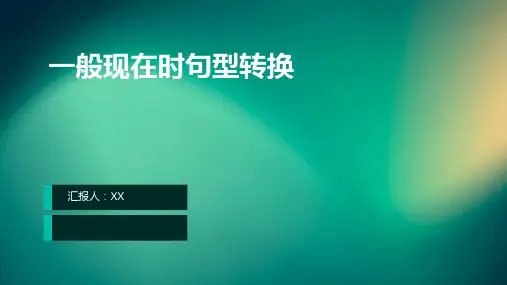
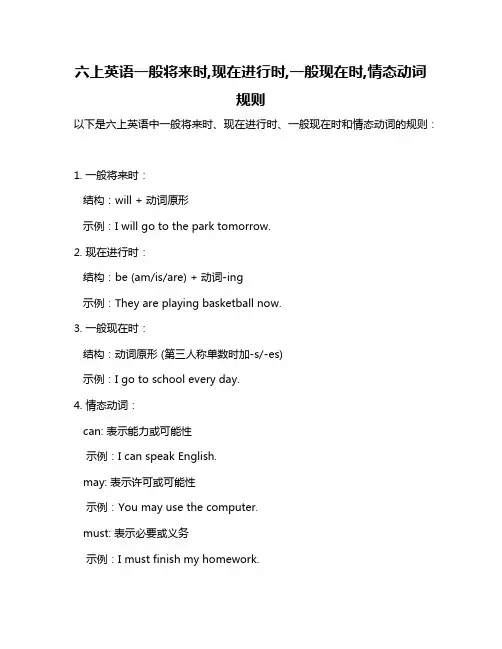
六上英语一般将来时,现在进行时,一般现在时,情态动词
规则
以下是六上英语中一般将来时、现在进行时、一般现在时和情态动词的规则:
1. 一般将来时:
结构:will + 动词原形
示例:I will go to the park tomorrow.
2. 现在进行时:
结构:be (am/is/are) + 动词-ing
示例:They are playing basketball now.
3. 一般现在时:
结构:动词原形 (第三人称单数时加-s/-es)
示例:I go to school every day.
4. 情态动词:
can: 表示能力或可能性
示例:I can speak English.
may: 表示许可或可能性
示例:You may use the computer.
must: 表示必要或义务
示例:I must finish my homework.
shall: 表示建议或命令
示例:You shall stay out of the garden.
will: 表示意愿或将来时间
示例:I will help you.
这些规则是英语语法中的基础部分,需要不断练习和巩固。
如需更多信息,建议查阅语法书籍或咨询英语教师。


小升初英语:一般现在时用法+句型转换详解一般现在时的构成一、一般现在时含有行为动词时,句子结构为:主语+行为动词+其它例如:I often go to the park on Sundays.星期天我经常去公园。
Tony reads English every morning.Tony每天早晨读英语。
They both like playing ball games.他们两个都喜欢球类运动。
注意:当主语为第三人称单数时,行为动词要加s或者es,变为第三人称单数形式。
练习:1)Mr. Green _____ (listen) to the radio every day.2)They all _____ (work) hard at school3)Mike _____ (study) in No.1 Middle School.二、含有系动词的一般现在时(1).含有be动词的一般现在时,句子结构为::主语+ be+表语+其它例如My name is Lily.我的名字是李莉。
I am from Guanzhou.我来自广州。
We are good friends.我们是好朋友be动词的变化: am is arebe动词用法口诀:我(I)用am你(you)用are,is永远跟着他(he)【它(it)、她(she)】,复数后面都是are。
练习:用be的正确形式填空1、I _____ an English girl.2、She _____ tall.3、Lucy and Lily _____ sisters.(2)系动词为感官动词,句子结构为::主语+感官动词+表语常用的感官动词有:look 看起来; taste 尝起来; smell 闻起来sound 听起来; feel 感觉起来;例如:He looks happy.他看起来很关高兴。
The dishes taste delicious .菜尝起来很美味。
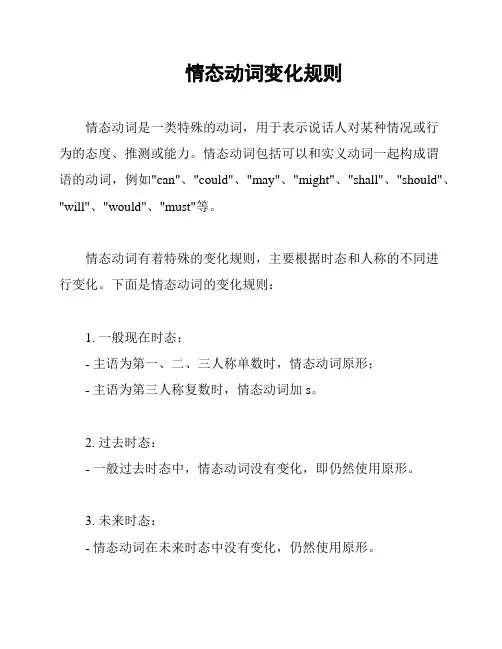
情态动词变化规则
情态动词是一类特殊的动词,用于表示说话人对某种情况或行
为的态度、推测或能力。
情态动词包括可以和实义动词一起构成谓
语的动词,例如"can"、"could"、"may"、"might"、"shall"、"should"、"will"、"would"、"must"等。
情态动词有着特殊的变化规则,主要根据时态和人称的不同进
行变化。
下面是情态动词的变化规则:
1. 一般现在时态:
- 主语为第一、二、三人称单数时,情态动词原形;
- 主语为第三人称复数时,情态动词加s。
2. 过去时态:
- 一般过去时态中,情态动词没有变化,即仍然使用原形。
3. 未来时态:
- 情态动词在未来时态中没有变化,仍然使用原形。
4. 否定形式:
- 情态动词的否定形式通常是在情态动词前加"not"。
5. 疑问形式:
- 在疑问句中,情态动词通常位于句首。
6. 被动语态:
- 构成被动语态时,情态动词后面接"be"动词的过去分词形式。
7. 完成时态:
- 情态动词没有自己的完成时态形式,但可以与"have"构成完
成时态。
需要注意的是,不同情态动词在不同语境中的用法也有所不同,具体用法需要根据具体语境进行判断。
以上是情态动词变化的基本规则,希望对您有所帮助。
仁爱版八年级上册期末专项复习之语法专练一、一般现在时1.句型转换1. Nancy is going to go camping.(改为否定句)Nancy ________ going to go camping.2. I’ll go and join them.(改为否定句)I _______ go ______ join them.3. I’m going to get up at 6:30 tomorrow.(改为一般疑问句)________ _______ ________ to get up at 6:30 tomorrow?4. We will meet at the bus stop at 10:30.(改为一般疑问句)_______ ________ meet at the bus stop at 10:30?5. She is going to listen to music after school.(对划线部分提问)________ _______ she ________ ________ _________ after school?6. My father and mother are going to see a play the day after tomorrow.(对划线部分提问)_________ _________ ________ father and mother going to see a play?7. We are going to play ping-pong on Saturday. (改为一般疑问句并作否定回答)—__________ __________ going to play ping-pong on Saturday?—__________, we __________.8. He’s going to tell me all about it. (改为否定句)He __________ __________ going to tell me all about it.9. She is going to work hard at English this term. (对划线部分提问)__________ she __________ this term?10. They’re going to the Sun Island by bus. (对划线部分提问)__________ __________they __________ __________ the Sun Island?11. The students of Class Three have a field trip on Sunday. (用next Sunday改写)The students of Class Three __________ __________ __________ __________ a field trip next Sunday.12. Linda has lunch at school on Tuesday. (用next Tuesday改写)Linda __________ __________ __________ __________ lunch at school next Tuesday.2用所给动词的适当形式填空。
六年级英语词型转换和句型转换方法及规律一、动词变单三:在一般现在时中,当主语是第三人称单数时,谓语动词要用第三人称单数形式,1、人称代词he, she, it是第三人称单数。
2、单个人名、地名或称呼作主语;是第三人称单数。
3、单数可数名词或"this / that / the+单数可数名词"作主语时,是第三人称单数。
4、不定代词someone, somebody, nobody, everything, something等及指示代词this, that作主语时,是第三人称单数。
5、不可数名词作主语时为第三人称单数。
6、当数字或字母作主语时,看作第三人称单数。
动词变单三的规律:附加特殊的动词: have单三has1.一般直接在动词词尾加s,如:make-makes 、like-likes 、read-reads2.以s,x,ch ,sh等结尾的动词变单三加es ,如:watch-watches teach-teaches wash--washes3.以辅音字母加o结尾的动词,加es 如: go-goes do-does4.以辅音字母加y结尾的动词,变y为i加es ,如:fly-flies 、study--studies二、动词现在分词(即ing形式)其规则如下:1、一般情况下直接在词尾加ing2、以不发音的字母e结尾的单词,去掉字母e,再加ingmake---making come---coming take---takingdance---dancing have---having write-writingskate-skating dance-dancing ride-riding若结尾的e 发音,就不能去掉,如:see-seeing3、以重读闭音节结尾,呈现“辅,元,辅”结构的动词,先双写末尾的辅音字母,再加ingrun-running, swim-swimming, get – getting,sit–sitting, put–putting, begin–beginning(visit,listen重读在前 ,不是以重读闭音节结尾,不用双写,直接加ing)4、以ie结尾的动词,把ie改为y ,再加ingdie---dying lie---lying名词变复数规律:1.一般名词复数是在名词后面加上“s”2.以s, sh, ch, x等结尾的名词变复数加“es”,如bus→bus es, dish→dishes watch→watch es,box→box es,peach→peach es3.以辅音字母+y结尾的名词变复数,把y变i加es,如bab y→bab ies, countr y→countr ies,factory→factoriesdictionary→dictionaries, university→universitiessecretary →secretaries , librar y→librar ies,(以元音字母+ y结尾的名词变复数时,直接加s变复数,如monk e y→monkeys, holid a y→holiday s, b o y→boy s);4.以o 结尾的名词变复数时:a)常见加es的名词有:土豆potato→potato es; 西红柿tomato→tomato esb)常见加s的名词有:photo→photo s,piano→piano s,radio→radio s, zoo→zoo s5、以e结尾加s :shoe→ shoe s ; rule→ rule s, bike→bike s6.以f或fe结尾的名词变复数时:去掉f, fe 加ves的名词有:hal f→hal ves; kni fe→kni ves lea f→lea ves ; wi fe→wi vesli fe→li ves人称代词和物主代词:一、人称代词二、物主代词1.含有be动词(am, is, are) 或情态动词(can,may,must,should) 的句子变一般疑问句,首先将be动词或情态动词提到句首,然后改变大小写及标点符号。
一般现在时的结构情态动词
以下是一些常见的情态动词在一般现在时结构中的用法:
1. can :表示能力或许可
- I can swim.(我会游泳。
)
- You can go now.(你可以走了。
)
2. may :表示可能性或许可
- May I use your phone?(我可以用你的手机吗?)
3. must :表示必须或肯定
- We must finish this project by tomorrow.(我们必须在明天前
完成这个项目。
)
- It must be true.(这一定是真的。
)
4. should :表示建议或期待
- You should eat more vegetables.(你应该多吃蔬菜。
)
- We should arrive before 8 o'clock.(我们应该在8点前到达。
)
5. ought to :表示应该或期待
- You ought to apologize to him.(你应该向他道歉。
)
- He ought to be more careful.(他应该更加小心。
)
需要注意的是,情态动词本身没有人称和数的变化。
而且在一般现在时结构中,动词用原形(除了第三人称单数形式需要加上“-s”或“-es”)。
例如:
- He can swim.(他会游泳。
)
- They can swim.(他们会游泳。
在英语中,不同时间里发生的动作或存在的状态,需要用不同的动词形式来表现,这就叫时态。
一般现在时<—————————————+————————————>一般过去时现在进行时一般将来时一般现在时1、定义:表示经常发生或习惯性的动作、状态。
句中通常有usually,often,every day,sometimes,always,at weekends,on Sundays等表示经常性时间的短语。
2、构成:1)当谓语是be动词时,一般现在时的构成:主语+be动词+其他如:I am a student. He is Jim’s father. They are from Japan.2)当谓语是行为动词时,一般现在时的构成:①主语(非第三人称单数)+动词原形+其他如:I often watch TV at the weekends.Mr Green and Mrs Green like collecting stamps.②主语(第三人称单数)+动词的第三人称单数形式+其他如:Jim usually visits his grandparents on Sundays.She sometimes goes to the park with her mother.3、动词三单形式的变化规则:1 一般情况下,直接加s 如:read-reads,swim-swims2 以s,x,sh,ch,o结尾,加es 如:wash-washes,watch-watches,do-does3 以辅音字母+y结尾,变y为i,再加es 如:study-studies,fly-flies4 不规则变化如:have-has4、一般现在时的句型转换:现在进行时1、定义:表示现在或现阶段正在进行或发生的动作。
句中常有now,look,listen等词。
如:I am washing clothes now.Look! Liu Tao is climbing the tree.Listen! Jane is singing in the music room.2、构成:be动词(am/is/are)+ 动词现在分词(V-ing)3、动词现在分词构成:1 一般是在动词原形后加ing如:read-reading,drink-drinking,eat-eating,look-looking2 以不发音的e结尾的动词,去掉e,再加ing如:write-writing,make-making,ride-riding,take-taking3 以重读闭音节结尾,如末尾只有一个辅音字母,要双写这个字母,再加ing如:sit-sitting,swim-swimming,put-putting,run-running,stop-stopping,get-getting,begin-beginning,jog-jogging,forget-forgetting4、动名词其实就是动词的现在分词,它既有名词性质(可作主语),又有动词性质(可带宾语)。
一般现在时的情态动词句型结构在我们的日常生活中,一般现在时的情态动词可真是个神奇的存在。
想象一下,早上醒来,阳光洒进窗子,咖啡香味四溢,你就会发现自己不知不觉中用上了这些动词,比如“can”,“must”,“should”。
真的是一种奇妙的感觉,像是在给生活加点调味料,让一切都变得生动有趣。
你可能会说,“我可以去跑步吗?”这个简单的句子就让你觉得清新又充满活力。
然后,假如你朋友问你,“你能帮我一下吗?”这时候,你心里肯定会想着,“当然可以啊!”心里想着帮助他,也许自己能顺便也锻炼一下。
说到“must”,你就会想到责任和义务。
生活中,常常有人对你说,“你必须完成这个项目!”当你听到这句话,脑海里可能瞬间闪过一百种逃避的理由。
不过,嘿,你也许会想到,这也是个锻炼自己的机会,是不是?“我必须去健身房,锻炼一下身体。
”这样的想法就像是给自己打了一针强心剂,让你充满斗志。
可到了健身房,你看到别人那身肌肉,心里又有点小怯,突然觉得,“我真的是应该多去几次!”这时候,你的心里充满了对自己的调侃,哈哈,生活不就是这样吗?再说到“should”,这可是一个很有意思的词。
你可以用它来建议别人,也可以用来提醒自己。
朋友聚会的时候,你可能会说,“我们应该点点好吃的!”这时候大家都点头同意,瞬间气氛就热络起来。
再比如,假如你正在努力学习,你心里会想,“我应该多花点时间在这个课题上。
”这样的自我鞭策就像是在给自己打气,让你坚持下去。
你也会听到别人说,“你应该好好休息一下。
”这时候,虽然嘴上不说,心里却很感激,毕竟谁不想有个温暖的提醒呢?情态动词的妙处还在于它们的多变。
比如,有时候你会想,“我能不能这周末去旅行?”这时候就会产生一种期待感,想象着那些美好的风景和美味的食物,心里瞬间充满了渴望。
生活中就是要多给自己点小惊喜,让每一天都像过节一样。
跟朋友一起聊天时,你们可能会说,“我们可以去看电影!”这时候,计划一下,决定好时间,大家的心情就会立刻被点燃。
初一英语一般现在时态讲解什么叫做时态?时态,是英语这门语言特有的现象,这与我们中文特有四个声调这种情况是相似的。
那么,什么叫做时态呢?时态,全称为时间与形态,都是针对动词来说的。
英语的动词在不同的时期内要呈现不同的形态。
孙悟空有七十二种种变化,猪八戒有三十六种变化,而动词也不逊色,它有五种变化,分别为动词原形、第三人称单数形式、过去式、过去分词、现在分词。
一般现在时,动词有两种变化:动词原形与第三人称单数。
记住这句话:时态是针对动词来说的。
一般现在时今天我们来学习一般现在时,这是最基本最重要的时态。
只要搞懂了这个时态了,掌握了这个时态,再去学其它时态就会易如反掌。
一般现在时,在时间轴上位于A点。
B A C过去现在将来时间轴一、总特点:一般现在时表示习惯性、经常性、反复性的动作或存在的状态。
“习惯性、经常性、反复性”是一般现在时的三大特性。
三大特性告诉我们,如果你要谈论的事情符合“习惯性,经常性和反复性”,比如你每天吃什么东西,吃多少,你的习惯等等,就要用到一般现在时。
二、什么时候用一般现在时?1.表示事物或人物的特征、状态。
The sky is blue.天空是蓝色的。
Mary’s father is an English teacher. 玛丽的爸爸是一名英语老师。
2.表示经常性或习惯性的动作。
I get up at six every day.我每天六点起床。
She plays sports every day. 她每天都做运动。
3.表示内心活动感情, 平时的喜好eg: I don't think you are right. 我认为你是对的。
I like ice cream. 我喜欢冰琪琳。
4.描述客观真理,科学原理,自然现象,等客观事实或格言谚语等eg 1)The earth moves around the sun. 地球绕太阳转。
2) The sun rises from the east. 太阳从东边升起。
情态动词用法: can, may, must, could, should, would , 后加动词原形。
1. He can play chess. 否定句:一般疑问句:
特殊疑问句:反义疑问句:
选择疑问句:(the guitar )
2. I can (can`t ~.)能力
I can`t work it out/ I can`t come on time./
I can`t carry the heavy box.
--- Can you spell Wendy,please
---Yes,I ,Wendy.
3. Can you ~(Could you ~) 能力,许可
Can you help me / swim / come at ten / dance / spell it / sing a song for us/ play with me /do me a big favor
4. may (may not) 可以,表许可
You may drive my car,but be careful.
Students may not stay out after midnight.
Don`t play with the knife, you may hurt yourself.
5. May I ~可以,表请求
May I help you / borrow your bike / use your eraser / speak to Sophie,please/have a look
---May I smoke here
---Yes, you may.
No, you mustn`t / can`t.
6. must 必须,应当
You must open the door at once, or else I`ll break it.
Work must come first.
---Must I go with them tomorrow
---No,you needn`t.( No,you don`t have to.)
7. You mustn`t ~.(You can`t ~.)不准,禁止
You mustn`t cross the road when the light is red /smoke here/ do it again.
8. should (ought to) 应该
Maybe,we should tell him the fact.
I think today`s children should learn to respect their elders.
9. Could you~请求
Could you do me a favor
---Could you lend me your dictionary
---Yes,of course.
you~愿意,表请求
Will you please tell me the secret
Will you have some coffee。